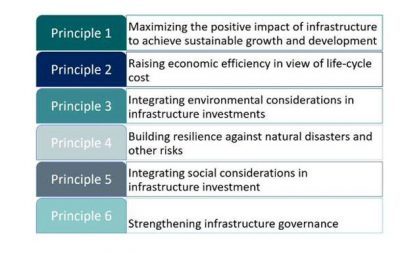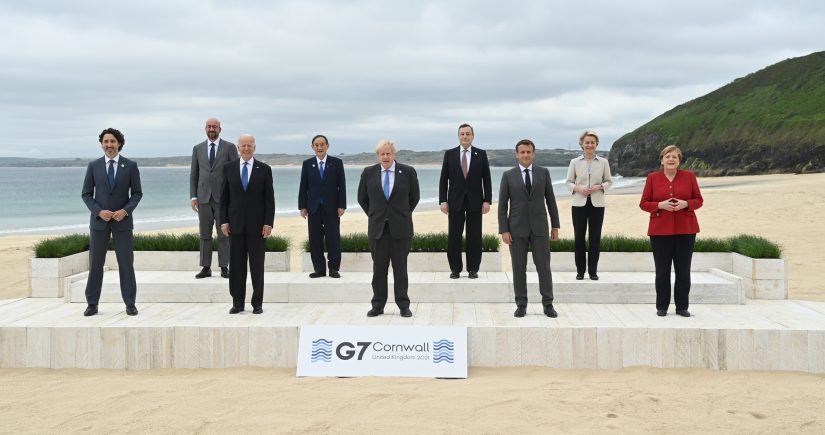In recent months we have seen infrastructure jump to the forefront of the geo-political map following the announcement of the G7’s Build Back Better World (B3W) initiative and the launch of the Blue Dot Network. The initiatives clearly represent a welcome opportunity to raise the standard of integrity and the quality of infrastructure on issues that have historically not been addressed, such as labour standards.

The initiatives build on the G20’s Quality Infrastructure Investment Principles (QII) which underpin a desire to improve the quality of infrastructure investment and reduce the risks for ‘bankable’ privately financed infrastructure projects. Whilst each of the six principles are vital, we were especially excited to see Principle 6 – Strengthening Infrastructure Governance included.
In this blog, we focus on how CoST contributes to this principle before demonstrating how it intends to broaden its contribution towards improving the integrity and quality of infrastructure investments by developing new tools that integrate environmental and social considerations (principles 3 and 5).
QII Principle 6: Strengthening infrastructure governance
For over a decade CoST has emphasised that the world’s infrastructure finance gap (estimated at approximately US$ 3.3 trillion per year to 2030) can be reduced by tackling waste and corruption in the sector. The IMF estimates that each time an infrastructure project is built an average of 30% is lost to inefficiencies. Even reducing this waste to 20 or 25% would produce savings in the billions would fund vital roads, energy plants, ICT networks and schools.
CoST has seen first-hand how improving transparency, participation and accountability provides a framework to safeguard infrastructure integrity. CoST disclosure standards, Infratech solutions such as open data platforms and its training of government officials have been critical to see data disclosed on over 60,000 infrastructure investments across CoST member countries. Evidence from Thailand indicates that such transparency and public scrutiny itself can have a deterrent effect, reducing bid prices for construction contracts, leading to estimated savings of close to US$ 500 million.
A CoST analysis of data from 300 individual investments across ten CoST member countries showed that poor project preparation has a significant impact on project delays and cost increases. Furthermore, it is often considered a key barrier to attracting private finance due to the risks and uncertainties associated with preparation aspects such as feasibility studies, financing models and design and site surveys.
This was illustrated by a recent CoST learning paper that highlighted the weaknesses in Coalianza – a unit established to oversee the delivery of 25 public-private partnership (PPP) infrastructure projects in Honduras. CoST Honduras raised awareness on these weaknesses such as poor management and distorted incentives for carrying out project appraisals, leading to the close of Coalianza in 2019 and the establishment of a new efficient body in its place. CoST Honduras’s work promoting transparency on these projects, including through the use of its PPP data platform SISOCS APP, also helped to improve environmental and social outcomes for seaports and changes to the financing of an economically unviable road project. Going forward, our plans to integrate the Open Contracting for Infrastructure Data Standard (OC4IDS) into SISOCS APP open source will allow investors to use the unique project reference number to track progress as it goes through each stage of the infrastructure project life-cycle, helping to reduce the risks and potential uncertainties.
We also have ambitious plans for our Infrastructure Transparency Index to further its ability to strengthen infrastructure governance. To date the results from initial CoST countries implementing the index have highlighted the strengths and weaknesses in their enabling environments for transparency in their contexts. The first step will be to present compelling visualisations of the results online so users can deep dive into the data, compare the performance of procuring entities, infrastructure sub-sectors and countries. Beyond that the skies are the limit – now rolled out across several diverse contexts – the index can be rapidly scaled up and applied beyond CoST members to enhance its global application measuring infrastructure governance.

Critical to achieving change is to engage a broad range of stakeholders – communities, local businesses, the media and others – who can discuss and identify solutions to the issues found in the data disclosed on projects. CoST engagement has included training journalists in Ethiopia, holding public radio debates in Malawi, facilitating community meetings in Thailand, empowering young people to monitor water and sanitation projects in Guatemala and convening government and the private sector to improve business integrity in Uganda.
These measures have resulted in numerous positive impacts including integrating road safety, waste management and flood alleviation measures into investments in Uganda, repairing poor quality roads and bridges in Ukraine and redesigning and allocating additional funding to ensure a new cancer hospital was built to international standards in Malawi.
Multi-Stakeholder Groups (MSGs) where government, the private sector and civil society collaborate in this reform have been critical to the introduction of these improvements, encouraging decision-makers to act on the evidence, respond to citizens’ concerns and drive institutional reforms that help to Raise Economic Efficiency in View of Life-Cycle Cost (Principle 2).
QII Principles 3 and 5: Integrating environmental and social considerations
In recent years CoST members have been pushing the envelope, taking innovate approaches to integrate environmental and social considerations (Principle 3 and Principle 5) into their approach. For example, CoST Honduras developed an award-winning prototype known as InfraS that analyses data from infrastructure investments to identify risks from environmental, social, economic and institutional perspectives.
CoST is committed to further integrating these considerations into its approach so that they are made transparent and accountable throughout the entire investment cycle. To do this we will work with our partners at the Open Contracting Partnership to develop the OC4IDS by adding new data points to capture social and environmental data.
We will also upgrade InfraS, allowing for the integration and analysis of different data sets to better understand the role of environmental and land use in disaster prevention as well as the impact on vulnerable and disadvantaged areas. Importantly, we will update the open-source code of the tool to allow its reuse by interested CoST members and partners.
We believe that by building on our work across principles 3 and 5 and maintaining our position as a leading initiative improving principle 6 we can help to meet the Sustainable Development Goals and pressing global issues such as shrinking civic space, gender inequality and climate change. Through this approach we can play a key role in contributing to overarching Principle 1 – maximising the positive impact of infrastructure to achieve sustainable growth and development. However we do require investment to do this. We therefore welcome discussion with those who share our values so that in partnership we can improve the quality of infrastructure investment worldwide.
Keep an eye out for our next blog which will look at the B3W initiative and Blue Dot Network more closely and assess their potential impact.
